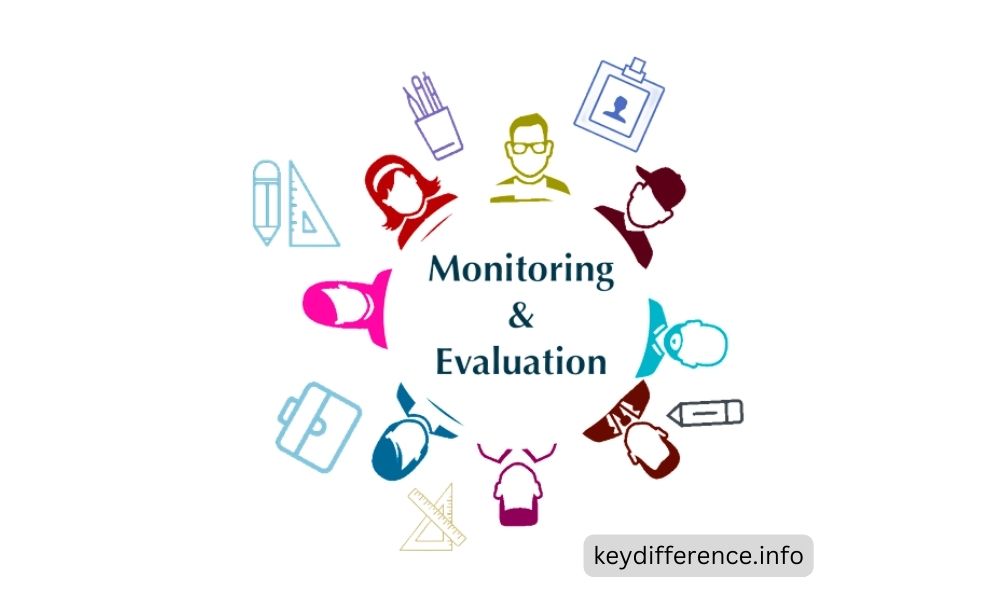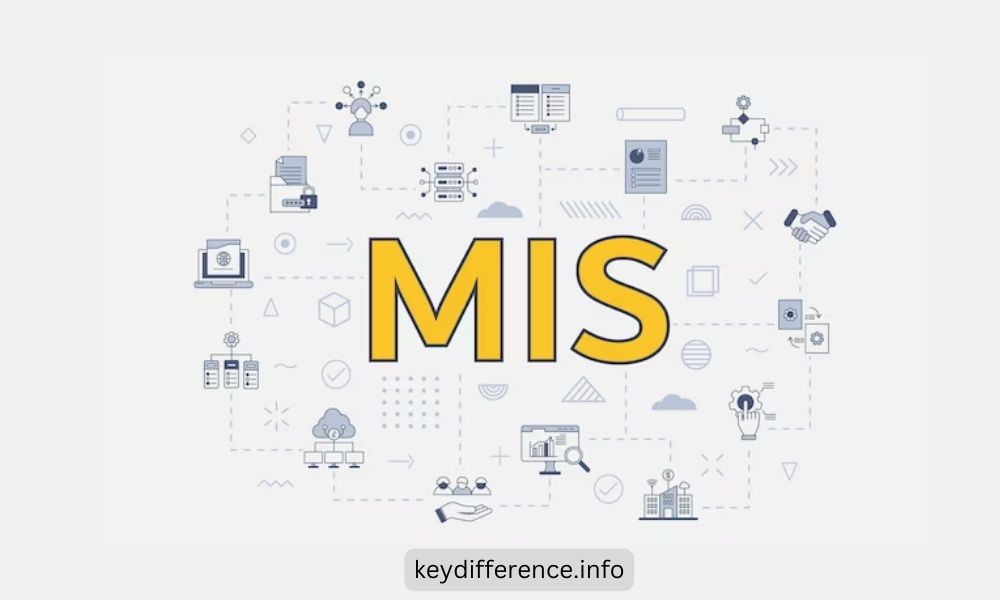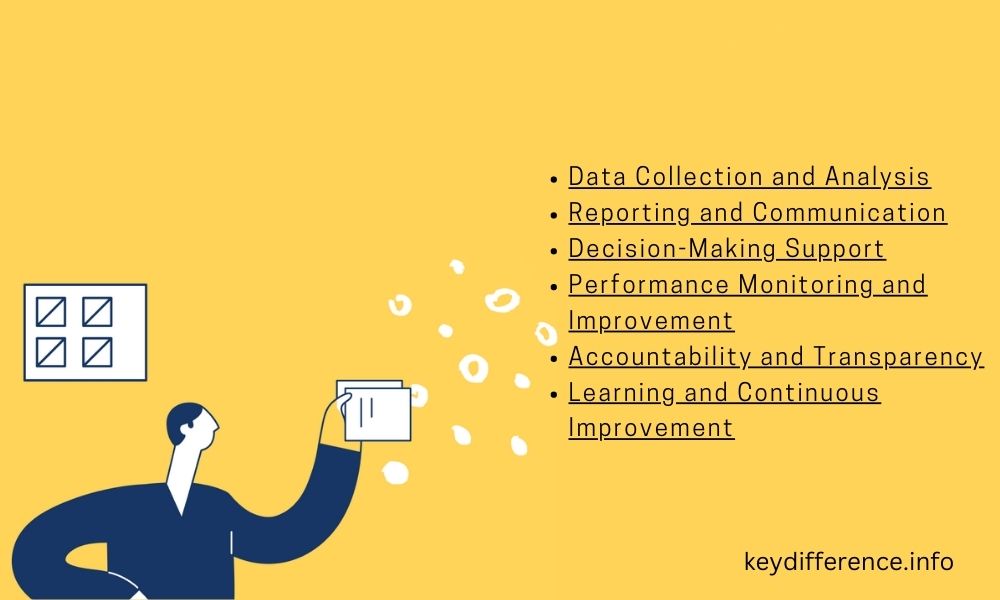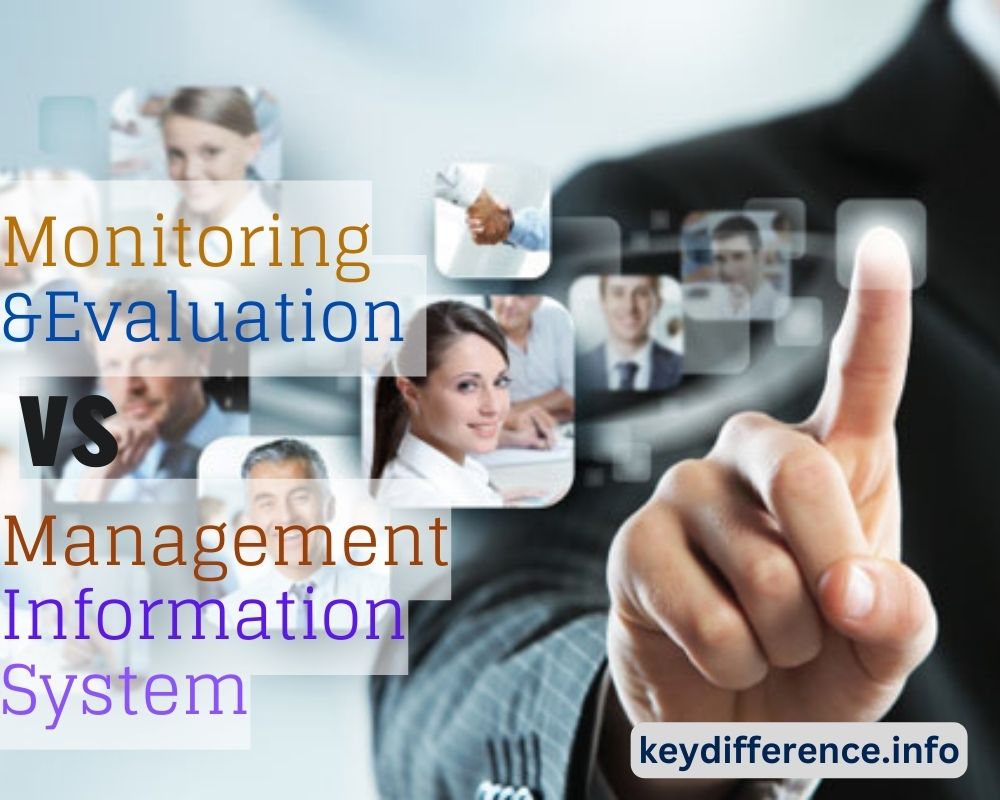M&E and MIS are terms that are often used in the corporate world as well as in large corporations. M&E is a reference to monitoring and evaluation, while MIS is a reference to Management Information Systems. In organizations and businesses collecting data on various areas and analysis thereof is essential for assessing past performance and identifying ways to improve the situation and improve effectiveness and output.
A lot of people are confused by the similarity of these phrases. There are some differences between them and this article will draw out these differences through a discussion of aspects of each concept.
Understanding Monitoring and Evaluation (M&E)

Monitoring and Evaluation (M&E) is a systematic process used to track and assess the progress, performance, and impact of programs, projects, or interventions.
It involves the collection, analysis, and interpretation of data to inform decision-making, improve accountability, and enhance program effectiveness.
Here are some key aspects to understand about M&E:
Purpose of M&E
- M&E aims to provide insights into the progress and achievements of programs or projects.
- It helps identify gaps, challenges, and areas for improvement.
- M&E enables evidence-based decision-making and ensures accountability to stakeholders.
Key Components of M&E
Monitoring
- Monitoring involves the continuous tracking and recording of activities, outputs, and outcomes of a program or project.
- It focuses on collecting data in a systematic and regular manner to measure progress towards objectives.
- Monitoring activities include data collection, data management, and analysis.
Evaluation
- Evaluation involves assessing the effectiveness, efficiency, relevance, and sustainability of a program or project.
- It aims to determine the impact and outcomes achieved, as well as identify factors influencing success or failure.
- Evaluation can be formative (conducted during program implementation), summative (conducted at the end of a program), or impact-focused (measuring long-term effects).
Data Collection Methods and Tools
- M&E relies on various data collection methods, such as surveys, interviews, focus groups, observations, and document reviews.
- Tools used for data collection include questionnaires, checklists, interview guides, and data recording forms.
- Data can be collected quantitatively (numerical data) or qualitatively (descriptive data) to provide a comprehensive understanding.
Continuous Tracking of Progress
- M&E involves regular monitoring to track the progress of activities and outputs against planned targets and indicators.
- This tracking helps identify potential issues, bottlenecks, or deviations from the intended course.
- Regular monitoring allows for timely corrective actions, adjustments, or reorientation if necessary.
Monitoring and Evaluation (M&E) is a process that involves systematic data collection, analysis, and interpretation to track progress, assess impact, and inform decision-making in programs or projects. It plays a crucial role in improving accountability, program effectiveness, and achieving desired outcomes.
Understanding Management Information System (MIS)

A Management Information System (MIS) is a computer-based system that collects, processes, stores, and disseminates data and information within an organization. MIS provides managers and decision-makers with timely, accurate, and relevant information to support planning, organizing, controlling, and decision-making processes.
Here are some key aspects to understand about MIS:
Purpose of MIS
- MIS aims to facilitate efficient management and decision-making by providing accurate and up-to-date information.
- It supports various functions within an organization, including strategic planning, operational management, and control.
- MIS helps managers make informed decisions based on data-driven insights.
Key Components of MIS
Data collection and management:
- MIS involves gathering, storing, and managing large volumes of data from various sources within an organization.
- Data collection can include manual entry, automated data capture, or integration with other systems.
- Data management involves organizing, validating, and maintaining data integrity to ensure its accuracy and reliability.
Information processing and analysis:
- MIS processes and analyzes data to transform it into meaningful information.
- It may involve data manipulation, calculations, statistical analysis, and modeling techniques.
- The processed information is presented in formats such as reports, dashboards, charts, and graphs for easy understanding.
Decision-making support
- MIS provides decision-makers with the necessary information to make informed and effective decisions.
- It offers insights, trends, and forecasts based on data analysis, helping identify opportunities, risks, and areas for improvement.
- MIS supports both routine operational decisions and strategic decisions at higher levels of management.
Integration of Technology
- MIS utilizes technology, such as databases, software applications, and network infrastructure, to manage and process data efficiently.
- It may involve the use of specialized software or enterprise resource planning (ERP) systems tailored to specific organizational needs.
- Technology enables data storage, retrieval, analysis, and reporting capabilities, ensuring real-time or near-real-time access to information.
Decision-Making Hierarchy
- MIS caters to different levels of management, providing information relevant to each level’s responsibilities.
- Operational-level MIS focuses on day-to-day operational activities and supports middle-level managers.
- Tactical-level MIS provides information for middle-level managers to monitor performance and make tactical decisions.
- Strategic-level MIS supports top-level executives in long-term planning and strategic decision-making.
A Management Information System (MIS) is a computer-based system that collects, processes, stores, and disseminates data and information within an organization. It supports management functions by providing timely, accurate, and relevant information for effective decision-making and operational control. MIS integrates technology and data analysis to enhance organizational performance and competitiveness.
Comparison table of M&E and MIS
| Aspect | Monitoring and Evaluation (M&E) | Management Information Systems (MIS) |
|---|---|---|
| Definition | Systematic process of tracking and assessing project or program performance and impact. | Comprehensive framework for collecting, processing, storing, and disseminating data to support decision-making. |
| Focus | Emphasizes performance, progress, and impact assessment. | Focuses on data management, analysis, and information dissemination. |
| Purpose | Provides real-time feedback for decision-making and continuous improvement. | Facilitates informed decision-making through data analysis and reporting. |
| Data Collection | Involves gathering relevant data to measure progress and outcomes. | Involves collecting and storing various types of data for analysis. |
| Analysis and Reporting | Analyzes data to assess effectiveness and make necessary adjustments. | Processes data for insights, generates reports, and visualizes information. |
| Stakeholder Involvement | Engages stakeholders to assess progress and outcomes. | Provides data to stakeholders at different organizational levels. |
| Time Frame | Continuous process throughout the project lifecycle. | Ongoing data collection and analysis for operational efficiency. |
| Use Cases | Used in project management, development programs, and policy implementation. | Applied in various sectors, including healthcare, education, finance, and more. |
| Decision Support | Aids in decision-making by providing real-time insights. | Supports decision-making through timely access to accurate information. |
| Accountability | Holds parties responsible for meeting targets and objectives. | Enhances transparency and accountability through accurate data reporting. |
| Technology | Relies on data collection tools, surveys, and performance indicators. | Utilizes technology for data storage, analysis, and reporting tools. |
| Impact Measurement | Measures the overall impact and effectiveness of projects or programs. | Measures impact through data analysis and trend identification. |
| Continuous Improvement | Drives continuous improvement through data-driven adjustments. | Supports improvement by providing insights into organizational processes. |
Synergies and Interactions Between M&E and MIS
The integration of M&E and MIS can create synergies and foster effective decision-making and performance improvement.
Here are some key ways in which M&E and MIS can interact and complement each other:
M&E as a Source of Data for MIS
- M&E generates valuable data during the monitoring and evaluation processes.
- This data can be used as inputs for MIS, providing real-time or periodic updates on program progress, outcomes, and impact.
- M&E data can enrich MIS databases, contributing to a comprehensive and accurate information system.
MIS Supporting M&E through Data Analysis and Reporting
- MIS can process and analyze large volumes of data efficiently, supporting M&E in data analysis and interpretation.
- MIS tools and techniques can help identify trends, patterns, and correlations within M&E data.
- MIS can generate reports, visualizations, and dashboards that facilitate the communication and presentation of M&E findings.
Collaborative Approaches for Effective Utilization of Both Systems
- M&E and MIS teams can collaborate to align data collection, reporting formats, and indicators.
- Sharing insights and findings between M&E and MIS teams can lead to improved data quality, accuracy, and relevance.
- Collaboration between M&E and MIS teams promotes a holistic view of data and enhances the organization’s understanding of program performance.
Feedback Loop and Learning
- M&E generates findings and recommendations that can be fed back into the MIS system for action and improvement.
- MIS can track the implementation of M&E recommendations, enabling a continuous learning process.
- Lessons learned from M&E can inform adjustments to data collection methods, indicators, or reporting formats in MIS, ensuring the system remains relevant and effective.
Decision-Making Support
- MIS provides decision-makers with timely and accurate information from various data sources, including M&E data.
- M&E data can contribute to evidence-based decision-making by providing insights into program effectiveness, impact, and areas for improvement.
- Decision-makers can leverage MIS capabilities to access M&E data and make informed decisions based on a broader organizational context.
By integrating M&E and MIS, organizations can leverage the strengths of both systems, enhance data-driven decision-making, improve program performance, and foster a culture of learning and accountability. The collaboration between M&E and MIS teams ensures that data is effectively collected, analyzed, and utilized to inform decision-making processes and improve overall organizational effectiveness.
Importance of implementing both systems for effective decision-making and performance improvement
Implementing both M&E and MIS is crucial for effective decision-making and performance improvement in organizations.
Here are the key reasons why both systems are important:
Evidence-Based Decision-Making
- M&E provides data and insights on program outcomes, impact, and effectiveness, enabling evidence-based decision-making.
- MIS complements M&E by providing timely and accurate information from various data sources, supporting informed decision-making at different levels of management.
- The integration of M&E and MIS ensures that decisions are based on reliable data, leading to more effective and informed choices.
Performance Improvement
- M&E identifies strengths, weaknesses, and areas for improvement in programs or projects.
- MIS facilitates performance tracking and monitoring, allowing organizations to identify and address performance gaps.
- The combination of M&E and MIS enables organizations to make data-driven adjustments, leading to improved program performance and outcomes.
Accountability and Transparency
- M&E promotes accountability by assessing the extent to which programs or projects achieve their objectives.
- MIS enhances accountability by providing transparent and accessible information on program progress, outcomes, and impact.
- The integration of M&E and MIS fosters transparency, enabling stakeholders to track program performance and hold organizations accountable for results.
Learning and Continuous Improvement
- M&E generates insights, lessons learned, and recommendations for program improvement.
- MIS supports the documentation and dissemination of M&E findings, facilitating organizational learning.
- The integration of M&E and MIS creates a feedback loop, allowing organizations to continuously learn, adapt, and improve their strategies and operations.
Resource Optimization
- M&E and MIS systems provide information that helps organizations allocate resources effectively and efficiently.
- M&E identifies areas where resources are most needed and assesses the cost-effectiveness of interventions.
- MIS provides real-time or periodic updates on resource utilization, enabling organizations to optimize resource allocation and improve efficiency.
Stakeholder Engagement and Communication
- M&E engages stakeholders in data collection, evaluation, and decision-making processes.
- MIS facilitates the communication of program information to stakeholders through reports, dashboards, and visualizations.
- The integration of M&E and MIS ensures effective stakeholder engagement and communication, enhancing collaboration and support for programs or projects.
Implementing both M&E and MIS systems is vital for effective decision-making and performance improvement in organizations. The combination of these systems enables evidence-based decision-making, promotes performance improvement, ensures accountability and transparency, fosters learning and continuous improvement, optimizes resource allocation, and enhances stakeholder engagement.
Organizations that embrace both M&E and MIS can achieve better outcomes, drive organizational effectiveness, and achieve their goals more effectively.
Emphasize the complementary roles of M&E and MIS

M&E and MIS play complementary roles in organizations, contributing to effective decision-making, performance improvement, and organizational effectiveness.
Here are the key aspects highlighting their complementary nature:
Data Collection and Analysis
- M&E focuses on collecting data specific to program outcomes, impact, and performance indicators.
- MIS collects and manages data from various sources within the organization, providing a broader organizational context.
- M&E data, when integrated into MIS, enriches the information pool, enabling comprehensive analysis and interpretation.
Reporting and Communication
- M&E generates reports, evaluations, and impact assessments to communicate program progress and outcomes.
- MIS provides reporting tools, dashboards, and visualizations for effective communication of data across the organization.
- The combination of M&E and MIS ensures that data is presented in a meaningful and accessible manner to inform decision-making and facilitate stakeholder engagement.
Decision-Making Support
- M&E provides insights and evidence on program effectiveness, impact, and areas for improvement.
- MIS supplies timely and accurate information from multiple data sources to support decision-making at different levels.
- M&E data contributes to the information provided by MIS, enabling a more comprehensive and informed decision-making process.
Performance Monitoring and Improvement
- M&E tracks and assesses program performance, identifying strengths and weaknesses.
- MIS facilitates real-time or periodic monitoring of operational performance and resource utilization.
- M&E data, integrated into MIS, enhances the monitoring capabilities and supports performance improvement initiatives.
Accountability and Transparency
- M&E holds organizations accountable by evaluating the achievement of program objectives.
- MIS promotes transparency by providing accessible and reliable information on program progress and outcomes.
- The integration of M&E and MIS enhances accountability and transparency, fostering trust and confidence among stakeholders.
Learning and Continuous Improvement
- M&E generates insights, lessons learned, and recommendations for program improvement.
- MIS facilitates the documentation, dissemination, and utilization of M&E findings, supporting organizational learning.
- M&E and MIS systems create a feedback loop that enables organizations to continuously learn, adapt, and improve their strategies and operations.
By recognizing and leveraging the complementary roles of M&E and MIS, organizations can capitalize on the strengths of each system. The integration of these systems enhances data-driven decision-making, promotes performance improvement, fosters accountability and transparency, supports organizational learning, and ultimately leads to more effective and impactful programs and projects.
Conclusion
M&E and MIS are two distinct yet interrelated systems that play crucial roles in organizations. While M&E focuses on tracking progress, assessing impact, and evaluating program effectiveness, MIS provides timely and relevant information to support decision-making, planning, and operational control. The complementary nature of M&E and MIS is vital for effective decision-making, performance improvement, and organizational effectiveness.
By integrating M&E and MIS, organizations can benefit from a comprehensive and data-driven approach to decision-making. M&E data enhances the information provided by MIS, enabling a deeper understanding of program outcomes and impact.
MIS, in turn, supports the processing, analysis, and reporting of data, facilitating effective communication and decision-making at all levels of management. The collaboration and synergy between M&E and MIS systems foster accountability, transparency, learning, and continuous improvement.

